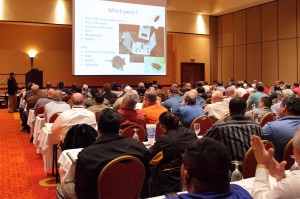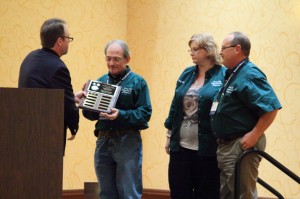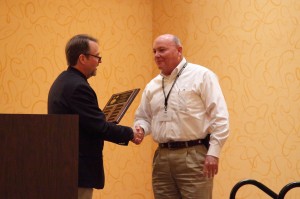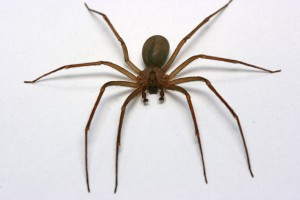
Many of you have heard about a new Texas Commission on Environmental Quality (TCEQ) requirement/regulation relating to pesticide applications to, over, or near water. The regulation is the result of federal court decisions which place pesticide applications and use under not only the
Federal Insecticide, Fungicide, and Rodenticide Act (FIFRA), but under the Clean Water Act (CWA).
TCEQ and other state environmental protection agencies nationwide (including Puerto Rico, Guam, and Samoa) had until October 31, 2011 to develop or adopt a Pollutant Discharge Elimination System (PDES) permit. TCEQ worked with stakeholders and EPA to develop an acceptable permit for Texans from all pesticide user communities (agriculture, structural pest management, governmental/political subdivisions, and consumer/homeowner…) to comply with without financial burden.
There are five sites of pesticide application to aquatic environments, which have thresholds requiring operators to file a “Notice of Intent” (NOI) with TCEQ ten (10) days prior to the application. A NOI is good for 1 year.
Operators are defined by TCEQ as individuals responsible for the site where pesticides will be applied. They can be an applicator (commercial or noncommercial), an entity (city or county), or an organization (homeowners association…) or an individual (farmer, rancher, or homeowner…).
1. Applications made to control “Mosquitoes and Other Flying Insect Pests” where the treatment area is greater than 6,400 contiguous acres and containing waters of the U.S. will require the “Operator” to submit a NOI ten (10) days prior to the application.
2a. Applications made to control “Aquatic Weeds and Algae” In Water where the treatment area exceeds 100 contiguous surface acres will require the operator to submit a NOI ten (10) days prior to the application.
2b. Applications made to control “Aquatic Weeds and Algae” At Water’s Edge where the treatment area exceeds 200 contiguous linear miles will need to file a NOI ten (10) days prior to the application.
3a. Applications made to control “Aquatic Nuisance Animals” (undesirable fish, lamprey eels…) In Water where the treatment area exceeds 100 contiguous surface acres will need to file a NOI ten (10) days prior to the application.
3b. Applications made to control “Aquatic Nuisance Animals” At Water’s Edge where the treatment area exceeds 200 contiguous linear miles will need to file a NOI ten (10) days prior to the application.
4. Applications made Over Forest Canopies for “Forest Canopy Pest Control” where the treatment area exceeds 6,400 contiguous acres and containing waters of the U.S. will need to file a NOI ten (10) days prior to the application.
5. Applications made for “Area Wide” pest control where the treatment area exceeds 6,400 contiguous acres and containing waters of the U.S. will need to file a NOI ten (10) days prior to the application.
There are three levels of compliance, each based on application site and access, type of entity making the pesticide application, and the size or distance of the application to, over, or near waters of the U.S.
Level I have two subcategories (Level IA and Level IB). The operator must insure applicators have TDA licenses for the application of restricted use or state-limited-use pesticides and regulated herbicides. In addition, Level IA operators (applicators) must submit a written or electronic NOI along with the appropriate fee(s) ten days before they commence any applications in a “Pest Management Area (PMA).” Annually they must file certain information for all pesticide applications to, over, or near waters of the U.S. with TCEQ.
Level IB operators (applicators) do not pay “NOI” fees, but they must submit a “Self Certification Letter” to the nearest TCEQ Regional Office ten (10) days before they commence any applications to, over, or near waters of the U.S. If they use restricted use or state-limited use pesticides, the applicator must be licensed with TDA. No annual reports are required. However, if an adverse incident occurs, the applicator must report the event to TCEQ within 24 hours
Level II and Level III are not subcategorized and have no financial or reporting implications for any affected operators (applicators). If restricted use or state-limited-use pesticides or regulated herbicides are applied, the applicator must have the appropriate TDA license. If an adverse incident occurs, the applicator must report the event to TCEQ within 24 hours.
All operators (applicators), including homeowners must keep records of all applications of pesticides to, over, or near waters of the U.S. regardless of threshold limitations for three years.
Click TPDES General Permit Requirement Matrix (PDF), which delineates each application area and the compliance efforts, fees, licensing requirements and reporting responsibilities based on the level of compliance an operator falls under.
More information about the TPDES, NOI Letters, and self-certification letters can be found under the AES website “Links” section http://www-aes.tamu.edu/links/
By Dr. Don Renchie, Professor and Team Leader, Ag & Environmental Safety







 .
.